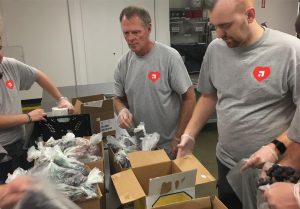One of the growing workplace trends is employees’ desire to bring the dimension of volunteerism to their work-life schedules. One survey found that 68% of respondents felt it was imperative or very important their employers provide them with paid time off to volunteer. Paid VTO is gaining traction but has a way to go before meeting the expectations of employees. According to SHRM, 26% of employers offer paid VTO, indicating plenty of room on the adoption curve for more employer participation.
Ivanti was one of the early adopters in this VTO employer trend. We launched a VTO program in 2013, encouraging employees to spend at least 8 hours per year dedicated to volunteering for STEM education activities.
In the early years of the program, our employees contributed several hundred volunteer hours annually. As a tech company we assumed everyone would want to participate, but we learned that engineering and science wasn’t necessarily everyone’s passion or comfort area. A tech company is made up of more than engineers and programmers, so just focusing volunteer efforts on STEM was limiting in attracting all employees to be volunteers. In 2019 we expanded VTO to be unlimited (as approved by an employee’s manager) and to accommodate any recognized non-profit. Our goal for the year was to have every employee volunteer at least one workday (eight hours), but obviously doing more is encouraged!
Week of caring
In 2019, Ivanti launched a major VTO initiative: Ivanti’s Week of Caring. The idea was to help every employee reach their eight hours of volunteering goal by getting each office (globally) to participate in a service activity.
Some of the week’s activities included:
- Assembling almost 200 food and sanitary packs for the homeless served by Black Pack Australia
- Walking shelter animals at a care facility in Warsaw
- Helping Tabitha’s Way, a Utah-based local food pantry. Fun fact: The director there had a software reporting problem and Ivanti’s software experts are helping her solve it.
- Making blankets for Primary Children’s Hospital in Salt Lake City
The Week of Caring surpassed expectations, with a total of 1,995.5 hours logged. Overall, the flexible approach and managerial support for volunteerism has dramatically increased volunteer hours, from just less than 700 hours in 2018 to 4,178 hours to date in 2019.
Putting VTO to work
Besides opening up the VTO program to a wider range of non-profits, there are a few practices we learned that can help others effectively launch a new VTO program or enhance an existing one:
- Get the word out — Make it easy for employees to find information on VTO. Advertise new opportunities as they arise. Give suggestions on where to volunteer. Post information on the company’s internal website where it is easily accessible.
- Plan ahead — Organizing a Week of Caring, or even a few days of caring, takes a concerted effort with HR, managers, team leaders, social media – the gamut of people involved in making a VTO initiative a success. Start early to assemble your VTO teams and map out timelines.
- Encourage managers to take part — Co-workers like to see their managers rolling up their sleeves as well. It helps to reinforce the importance of VTO – that the entire company is behind volunteerism. Ivanti CEO Steve Daly, for example, volunteered at the Utah Women’s Shelter during our Week of Caring.
- Bring volunteerism to the company sites — Employees may be concerned about taking time from work commitments. Think about volunteer activities that can be done on site. At Ivanti headquarters, Sue Urses, human resources vice president, brought the Primary Children’s Hospital project into a conference room so employees could help when it was convenient for them during their work day.
- Support group efforts — Working together on a VTO project is great for team building, particularly in more remote regions where employees may rarely get to company headquarters or campuses. Joining a project, for a day or two, helps give employees a larger sense of the organization and what it considers important activities. Whether working within their usual teams or volunteering with employees from different disciplines, the group approach can create a powerful dynamic in just a few days, with great VTO results.
Nurturing VTO year-round
Establishing a Week of Caring, or designating a few days for a company-wide focus, is only part of the VTO picture. To reach year-long volunteerism goals, VTO teams need to nurture an ongoing company culture. Fortunately, technology is now on everyone’s side. Communication through company internal web pages, social media and employee communications channels can all be used to keep volunteerism top of mind year-round.
To begin educating employees about your VTO program, starting with their first day on the job is always a good idea. At Ivanti, new employees learn about VTO during the onboarding process. This is the perfect time to impress upon employees how volunteerism and VTO benefits are part of the company culture and reflected in OKR (Objectives and Key Results). Employees have at least eight hours of VTO and, if they don’t have a particular charity in mind, this is the time to point them to an internal web page that can offer suggestions.
Logging VTO hours needs to be as easy as possible. The best scenario is to use the same approval process as PTO. An employee can select VTO from a drop-down menu, put in the number of hours they want and get the required OK from their manager.
Going forward, Ivanti is considering moving to two weeks of caring as the special event, and planning more frequent initiatives, most likely on a monthly basis. If there are more of these types of opportunities, it could prompt employees to sign up for more projects, thus increasing overall volunteer hours. We will take the approach, “If we book it, they will come!”
